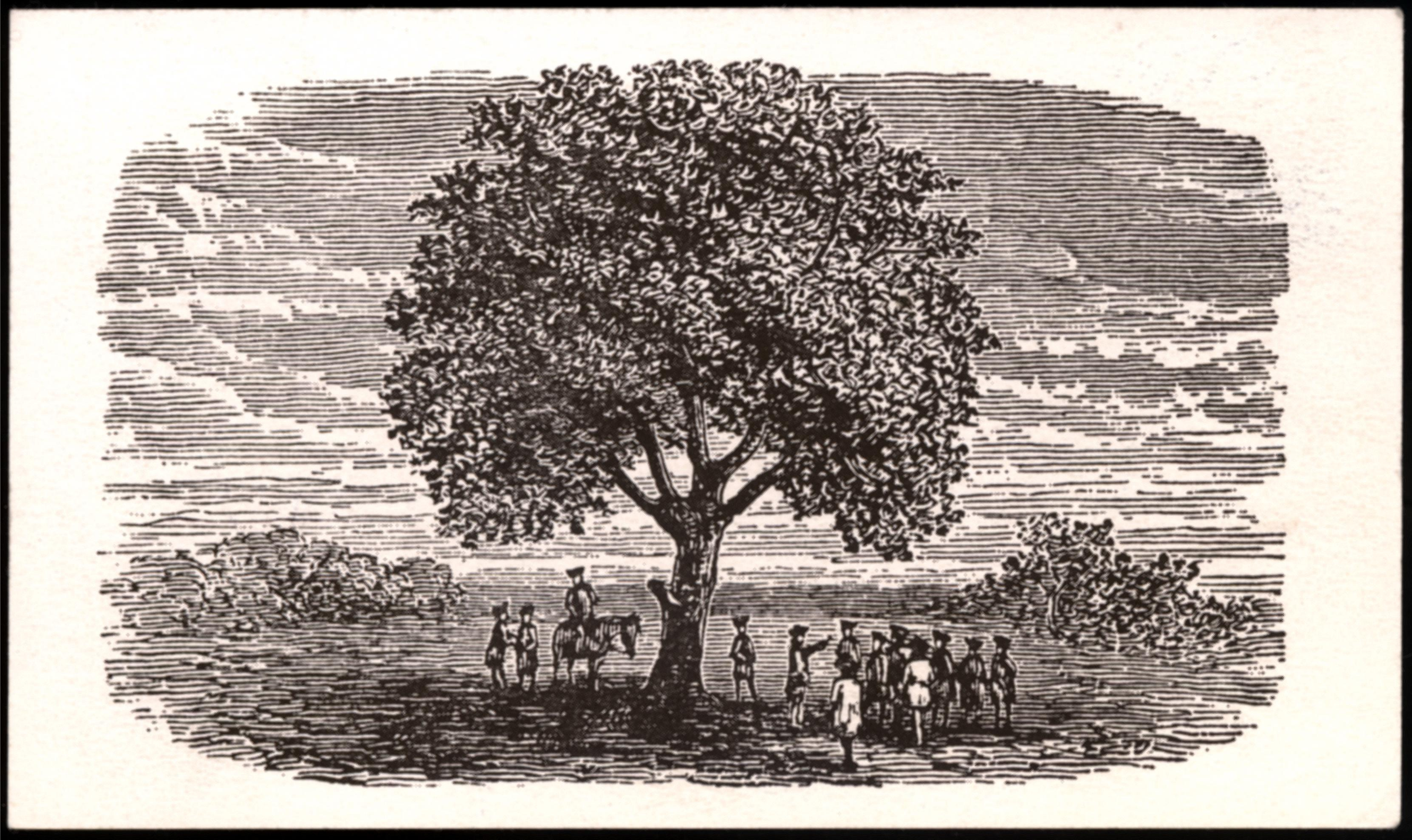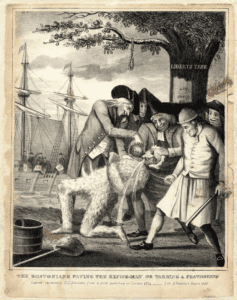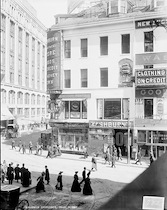
Legacy of the Liberty Tree: Where Is It Now in Present-Day Boston?

Written by Emily Yurkus, Visitor Experience Supervisor
When you hear the words Liberty Tree, do you picture a giant elm tree located in 18th century Boston? A place for people to gather, protest, and have their voices heard? A place where political effigies were hung and tarring and featherings took place? The Liberty Tree has an extensive—and complicated—legacy that has been left for present day Bostonians to learn about.

At the time of its designation in 1765, the Liberty Tree was a beloved symbol of hope and resistance throughout the colonies and in Boston. Other colonies were inspired by the Liberty Tree and designated their own. Well known figures such as the Marquis de Lafayette also commented on Boston’s Liberty Tree, saying “The world should never forget the spot where once stood Liberty Tree.”1 To Bostonians, it was a symbol of hope and resistance; all people, regardless of status, were able to gather at this spot to protest unfair representation in Parliament, and even in their own governments. These basic ideals of democracy would blossom into the founding of the country. But what actually happened at the Liberty Tree, and where is it today?
The Origin of the Liberty Tree
The tree that would one day be known as the “Liberty Tree” by 18th century colonists was planted around the year 1646 on Orange Street as part of an elm grove.2 Its location near Boston neck would have made the elm unmissable to everyone entering or leaving Boston.
On August 14, 1765, passerbys of the tree saw something unusual: an effigy of prominent Bostonian Andrew Oliver. As part of a protest against the Stamp Act, Bostonians hung an effigy of the proposed Stamp Tax Collector Andrew Oliver from the large elm.3 The protest of Andrew Oliver continued with the destruction of his home. According to Governor Francis Bernard, the protestors “beheaded the effigy; and broke all the windows next to the street” of Oliver’s home. Oliver managed to escape and soon sent a notice of his resignation from the office of Stamp Tax Collector.4
Soon after, in March of 1766, the Stamp Act was repealed without ever having been successfully implemented in the colonies. The colonists celebrated at the elm grove and installed a copper sign designating it the Liberty Tree. They hung up 150 lanterns as part of their celebration, one of which is now displayed at the Old State House.
A Symbol of Protest

Engraving
Phillip Dawe, 1774; Printed by William S. Pendleton
c. 1830
Revolutionary Spaces, 1889.0034.001
This wasn’t the last time the Liberty Tree was used to protest taxes. In November of 1773, Bostonians protested the Tea Act at the great elm, this time targeting the merchants who supported the act. On November 1, 1773, notifications were posted around the town calling for Bostonians “to meet at the Liberty Tree […] to hear the persons to whom the tea, shipped by the East India Trading Company, is consigned, make a public resignation of their office as consignees, upon oath.”5 The tea consignees did not adhere to the demands and did not go to the Liberty Tree. A little more than a month after this, the event now known as the Boston Tea Party occurred, starting at the Old South Meeting House and ending at Griffin’s Wharf.
Non-violent, albeit threatening, protests were not the only acts of political expression committed at the Liberty Tree. The colonists took justice into their hands multiple times between 1765 and 1775. The most famous instance occurred in 1774, when British custom official John Malcom was tarred and feathered, dragged through the streets of Boston, and forced to symbolically drink tea beneath the Liberty Tree. Patriots hung a noose around Malcolm’s neck and demanded he denounce the British governor under threat of death. Malcom refused, and the Sons of Liberty released him.6
Where Is the Liberty Tree Now?
In 1775, the Liberty Tree was cut down by occupying British soldiers and used as firewood. Their act was intended to destroy a powerful symbol of resistance, protest, and revolution. After the Revolution, Boston designated the stump of the Liberty Tree as the Liberty Stump.7 For unknown reasons, the stump is no longer here today.

Wool
1770s
Revolutionary Spaces, 1893.0093
Today, there is a small Liberty Tree plaza, which was installed in 2018, and a wooden plaque carved in 1850, which is located on a Massachusetts Registry of Motor Vehicles building. The site of the once great Liberty Tree is far off the Freedom Trail, at the intersection of Washington and Essex Streets. It is located in the once notorious “Combat Zone,” which had been known as an area for adult entertainment and violence from the 1960s to the 1990s before it was cleaned up by the city.8 Perhaps as part of the effort to rebrand this zone, the city marked the Liberty Tree area as a National Historical site in 1980—too late to be a part of the Freedom Trail, which was established in 1951.9
Remembering the Liberty Tree Today

c. 1908
Revolutionary Spaces, VW0001.003579
Nowadays, we see that most sites on the Freedom Trail did not allow everyone to share their voices. The government in the Old State House only represented about 15 percent of the population due to restrictions on who could vote and serve in the government. The Old South Meeting House was a bit more inclusive, but still excluded large swaths of Boston from political participation. The one place that everyone’s voices could be heard would have been the Liberty Tree– which is not on the Freedom Trail. What do we lose by not having this site on the most popular historic trail in Boston?
While the Liberty Tree does not necessarily have to be on the Freedom Trail, perhaps it should still be questioned and mentioned more throughout discussions about the Sons of Liberty and Revolutionary Boston. The Liberty Tree is a microcosm for the ideal American nation; a place where disenfranchised citizens could gather, create community, exchange political ideology, and ultimately work to have their voices heard. This alone means that the story of the Liberty Tree is worth remembering.
Footnotes:
- Erick Trickey, “The Story behind a Forgotten Symbol of the American Revolution: The Liberty
Tree.” Smithsonian Magazine. 19 May 2016. https://www.smithsonianmag.com/history/story-behind-forgotten-symbol-american-revolution-liberty-tree-180959162/ - Trickey, “The Story behind a Forgotten Symbol of the American Revolution.”
- R. S. Longley, “Mob Activities in Revolutionary Massachusetts.” The New England Quarterly 6, no. 1 (1933): 98–130. https://doi.org/10.2307/359364.
- Trickey, “The Story behind a Forgotten Symbol of the American Revolution.”
- Drake, Francis S. Tea Leaves. (1884). 282-284.
- Trickey, “The Story behind a Forgotten Symbol of the American Revolution.”
- Trickey, “The Story behind a Forgotten Symbol of the American Revolution.”
- Tim Reynolds, “A Look at the Rise and Fall of the Notorious Boston Combat Zone.” Medium. 14 June 2022. https://treynolds111.medium.com/a-look-at-the-rise-and-fall-of-the-notorious-boston-combat-zone-9ac6355ef097
- “National Registry of Historic Places Inventory-Nomination Form.” https://npgallery.nps.gov/GetAsset/1ccc770c-b917-4b4b-8cc4-dde9a8a89c27
Reynolds, “A Look at the Rise and Fall of the Notorious Boston Combat Zone.”
Works Cited:
Blakemore, Erin.”Why the ‘Liberty Tree’ Became an Obsession After the Revolutionary War.”History. 5 July 2018. https://www.history.com/news/liberty-trees-symbol-revolutionary-war
Drake, Francis S. Tea Leaves. (1884). 282-284.
Longley, R. S. “Mob Activities in Revolutionary Massachusetts.” The New England Quarterly 6, no. 1 (1933): 98–130. https://doi.org/10.2307/359364.
“National Registry of Historic Places Inventory-Nomination Form.” https://npgallery.nps.gov/GetAsset/1ccc770c-b917-4b4b-8cc4-dde9a8a89c27
Reynolds, Tim. “A Look at the Rise and Fall of the Notorious Boston Combat Zone.” Medium. 14 June 2022. https://treynolds111.medium.com/a-look-at-the-rise-and-fall-of-the-notorious-boston-combat-zone-9ac6355ef097
Smith, John L. “Visiting Boston’s Liberty Tree Site.” Journal of the American Revolution. 21 April 2015. https://allthingsliberty.com/2015/04/visiting-bostons-liberty-tree-site/
Trickey, Erick. “The Story behind a Forgotten Symbol of the American Revolution: The Liberty Tree.” Smithsonian Magazine. 19 May 2016. https://www.smithsonianmag.com/history/story-behind-forgotten-symbol-american-revolution-liberty-tree-180959162/

